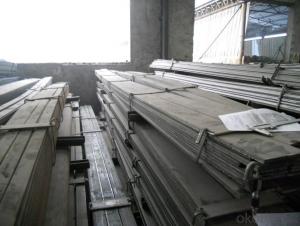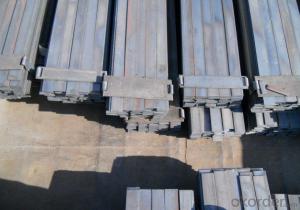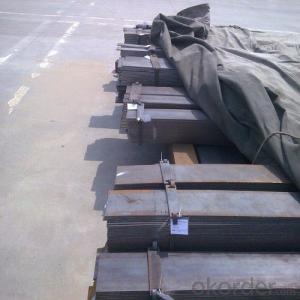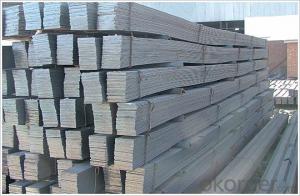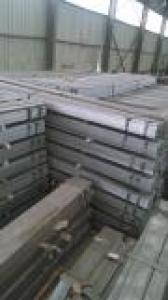Hot Rolled Steel Flat Bar with Enough Thickness 10mm Chinese Standard
- Loading Port:
- China main port
- Payment Terms:
- TT or LC
- Min Order Qty:
- 25 m.t.
- Supply Capability:
- 10000 m.t./month
OKorder Service Pledge
OKorder Financial Service
You Might Also Like
1. Structure of Hot Rolled Steel Flat Bar with Enough Thickness 10mm Chinese Standard Description:
Hot rolled steel flat bar with enough thickness 10mm Chinese standard is a beam with an I-shaped cross-section. The horizontal elements of the "I" are known as flanges, while the vertical element is termed the "web". Hot rolled steel flat bar with enough thickness 10mm Chinese standard is usually made of structural steel and is used in construction and civil engineering. The hot rolled steel flat bar with enough thickness 10mm Chinese standard resists shear forces, while the flanges resist most of the bending moment experienced by the beam. Hot rolled steel flat bar with enough thickness 10mm Chinese standard theory shows that the I-shaped section is a very efficient form for carrying both bending and shears loads in the plane of the web.
2. Main Features of Hot Rolled Steel Flat Bar with Enough Thickness 10mm Chinese Standard:
• Grade: Q235
• Type: Mild carbon steel
• Deflection: The stiffness of the I-beam will be chosen to minimize deformation
• Vibration: The stiffness and mass are chosen to prevent unacceptable vibrations, particularly in settings sensitive to vibrations, such as offices and libraries.
• Local yield: Caused by concentrated loads, such as at the beam's point of support.
3. Hot Rolled Steel Flat Bar with Enough Thickness 10mm Chinese Standard Images:

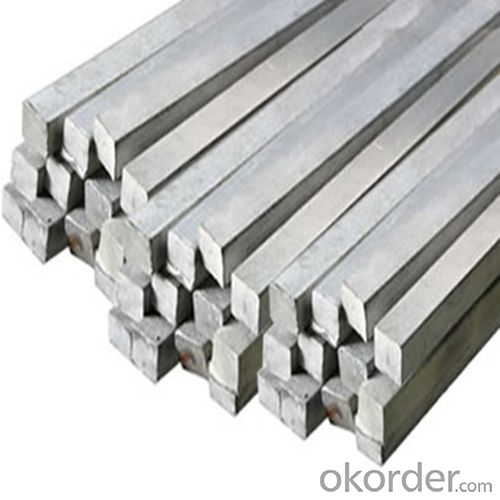
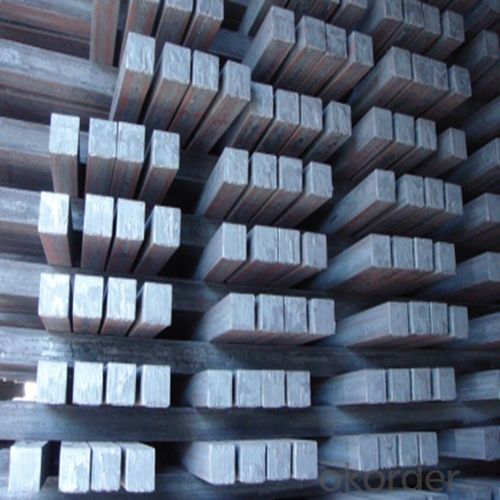
4. Hot Rolled Steel Flat Bar with Enough Thickness 10mm Chinese Standard Specification:
Alloy No | Grade | Element(%) | ||||
C
| Mn
| S
| P
| Si
| ||
Q235
|
B
|
0.12—0.20 |
0.3—0.7 |
≤0.045 |
≤0.045
|
≤0.3
|
Alloy No | Grade | Yielding strength point(Mpa) | Tensile strength (Mpa) | Elongation after fracture(%) | ||||||
Thickness (mm) | Thickness (mm) | |||||||||
≤16 | >16--40 | >40--60 | >60--100 | ≤16 | >16--40 | >40--60 | >60--100 | |||
≥ | ≥ | |||||||||
Q235 |
B |
235 |
225 |
215 |
205 |
375--500 |
26 |
25 |
24 |
23 |
5. FAQ
We have organized several common questions for our clients,may help you sincerely:
①Is this product same as W beam?
In the United States, the most commonly mentioned I-beam is the wide-flange (W) shape. These beams have flanges in which the planes are nearly parallel. Other I-beams include American Standard (designated S) shapes, in which flange surfaces are not parallel, and H-piles (designated HP), which are typically used as pile foundations. Wide-flange shapes are available in grade ASTM A992,[4] which has generally replaced the older ASTM grades A572 and A36.
②How to inspect the quality?
We have a professional inspection group which belongs to our company. We resolutely put an end to unqualified products flowing into the market. At the same time, we will provide necessary follow-up service assurance.
③Is there any advantage about this kind of product?
Steel I beam bar IPE has a reduced capacity in the transverse direction, and is also inefficient in carrying torsion, for which hollow structural sections are often preferred.
- Q:Can steel flat bars be used for making tools or machinery?
- Yes, steel flat bars can be used for making tools or machinery. Steel flat bars are commonly used in the manufacturing industry due to their strength, durability, and versatility. They can be easily shaped, cut, and welded to create various components or structures required in tools or machinery. Steel flat bars have high tensile strength, which makes them suitable for bearing heavy loads and resisting wear and tear. Additionally, their uniform shape and smooth surface allow for precise machining and assembly, making them ideal for constructing tools or machinery with tight tolerances. Overall, steel flat bars are a popular choice in the industry for their reliability and suitability in the production of tools and machinery.
- Q:What are the different types of surface coatings for steel flat bars?
- There are several types of surface coatings available for steel flat bars, including galvanized coatings, powder coatings, epoxy coatings, and painted coatings. These coatings can provide protection against corrosion, enhance durability, improve aesthetics, and offer various levels of resistance to chemicals and abrasion. The choice of coating depends on the specific requirements and intended use of the steel flat bars.
- Q:What are the common forming techniques used for steel flat bars?
- Some of the common forming techniques used for steel flat bars include hot rolling, cold rolling, and extrusion. Hot rolling is a process where the steel is heated above its recrystallization temperature and passed through a series of rollers to reduce its thickness and shape it into a flat bar. This technique is commonly used to produce steel flat bars with precise dimensions and a smooth surface finish. Cold rolling, on the other hand, involves passing the steel through rollers at room temperature. This process is typically used to further refine the thickness and surface finish of the steel flat bar produced through hot rolling. Cold rolling can also increase the strength and hardness of the steel. Extrusion is another forming technique that involves forcing the steel through a die to shape it into a flat bar. This process is commonly used for producing steel flat bars with complex cross-sectional profiles or when there is a need for a high degree of precision in the final product. Other forming techniques for steel flat bars may include bending, shearing, and welding. Bending is often used to achieve specific shapes or angles in the flat bar, while shearing is used to cut the flat bar to the desired length. Welding is a joining process that can be used to connect multiple steel flat bars together or to other steel components.
- Q:How do steel flat bars compare to glass flat bars?
- Steel flat bars are much stronger and more durable than glass flat bars. They have a higher tensile strength and are resistant to bending and breaking, making them suitable for heavy-duty applications. Glass flat bars, on the other hand, are more fragile and prone to shattering under pressure. They are primarily used for decorative purposes or in situations where transparency is required.
- Q:What is the typical hardness range for steel flat bars?
- The typical hardness range for steel flat bars can vary depending on the specific grade and heat treatment of the steel. However, in general, the hardness range for steel flat bars falls between 120 and 300 on the Brinell hardness scale (HB). This range is commonly used for various industrial applications, including construction, manufacturing, and toolmaking. It is important to note that the desired hardness range for steel flat bars will ultimately depend on the intended use and specific requirements of the project.
- Q:Can steel flat bars be used for making shelving or storage racks?
- Yes, steel flat bars can be used for making shelving or storage racks. Steel flat bars are strong and durable, making them suitable for supporting heavy loads and providing stability to shelving units or storage racks. They can be easily cut and welded to create custom sizes and shapes, allowing for flexibility in design. Additionally, steel flat bars have a sleek and modern appearance, making them suitable for various types of storage environments such as warehouses, garages, or even homes. Overall, steel flat bars are a reliable and versatile choice for constructing shelving or storage racks.
- Q:What are the different methods of surface protection for steel flat bars?
- There are several methods of surface protection for steel flat bars. These include galvanizing, painting, powder coating, and applying a protective coating or film. Each method offers varying degrees of corrosion resistance and aesthetic appeal, allowing for the steel flat bars to be effectively protected against environmental factors and prolong their lifespan.
- Q:What are the standard tolerances for width and thickness in steel flat bars?
- The standard tolerances for width and thickness in steel flat bars vary depending on the specific industry and application. However, commonly accepted tolerances for width range from +/- 0.005 to +/- 0.030 inches, while tolerances for thickness typically fall within +/- 0.002 to +/- 0.020 inches. It is important to consult the relevant industry standards or manufacturer specifications for precise tolerances required for a specific steel flat bar.
- Q:What are the different cutting methods for steel flat bars?
- There are several cutting methods for steel flat bars, including sawing, shearing, and plasma cutting. Sawing involves using a saw blade to cut through the bar, while shearing uses a shearing machine to trim the material. Plasma cutting, on the other hand, involves using a high-temperature plasma torch to melt and separate the steel. Each method has its own advantages and is suitable for different applications and requirements.
- Q:Are steel flat bars suitable for architectural applications?
- Indeed, architectural applications can make good use of steel flat bars. Their durability, strength, and versatility make them a popular choice in various architectural designs. Steel flat bars can be easily manipulated and molded into different shapes, allowing for the creation of distinctive architectural elements. They are frequently employed in the construction of frames, supports, and ornamental features in buildings, bridges, and other structures. Furthermore, steel flat bars exhibit excellent resistance to corrosion, a vital characteristic for preserving the visual appeal and longevity of architectural designs. In conclusion, steel flat bars provide a dependable and visually pleasing solution for architectural applications.
1. Manufacturer Overview |
|
|---|---|
| Location | |
| Year Established | |
| Annual Output Value | |
| Main Markets | |
| Company Certifications | |
2. Manufacturer Certificates |
|
|---|---|
| a) Certification Name | |
| Range | |
| Reference | |
| Validity Period | |
3. Manufacturer Capability |
|
|---|---|
| a)Trade Capacity | |
| Nearest Port | |
| Export Percentage | |
| No.of Employees in Trade Department | |
| Language Spoken: | |
| b)Factory Information | |
| Factory Size: | |
| No. of Production Lines | |
| Contract Manufacturing | |
| Product Price Range | |
Send your message to us
Hot Rolled Steel Flat Bar with Enough Thickness 10mm Chinese Standard
- Loading Port:
- China main port
- Payment Terms:
- TT or LC
- Min Order Qty:
- 25 m.t.
- Supply Capability:
- 10000 m.t./month
OKorder Service Pledge
OKorder Financial Service
Similar products
New products
Hot products
Hot Searches
Related keywords






